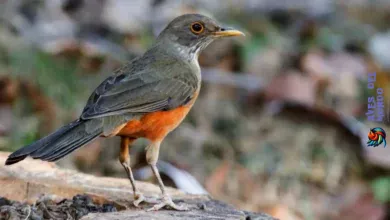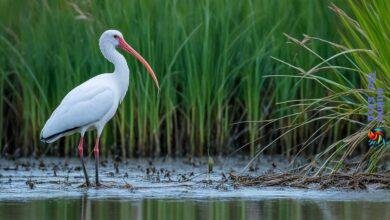Did you know that there are over 144 species of cuckoo birds worldwide? These incredible avian creatures have long fascinated bird enthusiasts and scientists alike with their unique behaviors and intriguing characteristics. From their parasitic nesting habits to their impressive migration patterns and iconic calls, there is so much to discover about these enigmatic birds. Join us as we delve into the intriguing world of cuckoo birds, exploring their fascinating facts, behaviors, habitats, and more.
Throughout the course of this article, we will uncover the mysteries surrounding cuckoo bird nesting habits, their strategic brood parasitism, and the remarkably long journeys they undertake during migration. We will also examine their preferred habitats and dietary preferences, shedding light on their intricate interactions with the environment.
Whether you’re a birdwatching enthusiast, a nature lover, or simply curious about the incredible diversity of our feathered friends, this comprehensive guide on cuckoo birds is sure to captivate your interest. Let’s embark on this fascinating journey to uncover the secrets of the cuckoo bird.
The Mysterious Call of the Cuckoo Bird
One of the most recognizable features of the cuckoo bird is its distinctive call. The cuckoo’s call is often associated with the arrival of spring and is instantly recognizable. This iconic call has inspired composers, poets, and playwrights throughout history. Learning to identify the cuckoo bird’s call can enhance your birdwatching experience and help you appreciate this unique species even more.
When it comes to the cuckoo bird call, it is known for its repetitive and rhythmic sound. The male cuckoo emits the famous «cuck-oo» call, with the second note usually higher-pitched and louder than the first. This characteristic call is unforgettable and easily distinguishable from the calls of other bird species.
«The song of the cuckoo…the cuckoo himself, participating in all the joys of spring: seen delicately perching on the tops of the trees in conclave during the breeding season and heard calling and caroling in the summer—the very bird of the British spring—a bird to rejoice in»
– W. H. Hudson, British Birds
With practice and experience, you can become adept at identifying the cuckoo bird’s call. Listening to recordings and observing the bird’s behavior can aid in recognition. Remember, the cuckoo’s call can vary slightly between individuals, so familiarizing yourself with the general pattern and quality of the call will help you in accurate identification.

The iconic cuckoo call not only adds melody to our natural surroundings, but it also serves an important purpose in the cuckoo bird’s lifecycle. The male cuckoo uses its call to attract a female mate and establish its territory. The female cuckoo, on the other hand, has a completely different bubbling call, often described as resembling the sound of water pouring from a bottle.
«I hear thee call me forth again,
O’er woods and wilds and lofty hills,
I seek thee still, I seek in vain,
I’ve thrown away so many hills.»
– Samuel Taylor Coleridge, The Complete Poems
The enchanting cuckoo bird call is a true testament to the wonders of nature and the intricate world of bird communication. By honing your ability to identify this iconic call, you can elevate your birdwatching adventures and gain a deeper appreciation for the fascinating behavior of the cuckoo bird.
The Fascinating Nesting Habits of the Cuckoo Bird
The cuckoo bird possesses a truly extraordinary nesting strategy known as brood parasitism, which sets it apart from other avian species. Rather than building its own nest and raising its young, the cunning cuckoo bird chooses a different approach. It lays its eggs in the nests of unsuspecting host species, tricking them into incubating and caring for its offspring.
Each female cuckoo bird specializes in targeting specific host species, such as reed warblers or meadow pipits. By selecting particular hosts, the cuckoo bird ensures that its eggs closely match the appearance of the host bird’s own eggs. This remarkable ability for mimicry helps the cuckoo egg evade detection, fooling the unsuspecting host into accepting it as their own.
«The cuckoo egg is expertly camouflaged to look like the host bird’s eggs, fooling the unsuspecting host into incubating and caring for the cuckoo chick.»
This clever deception is not limited to the appearance of the cuckoo egg. Once the cuckoo chick hatches, it continues to mimic the behavior and appearance of the host species’ chicks. This ensures that the adult birds continue to provide for and care for the impostor, even at the expense of their own offspring.
This remarkable nesting strategy has evolved over time, allowing the cuckoo bird to focus its energy on reproduction rather than building nests and raising young. It is a true testament to the ingenuity and adaptability of nature.

Cuckoo Bird Host Species
| Host Species | Preferred Host Species |
|---|---|
| Reed Warbler | Eurasian Cuckoo |
| Meadow Pipit | Common Cuckoo |
| Dunnock | Great Spotted Cuckoo |
Through the remarkable phenomenon of brood parasitism and its expertise in egg mimicry, the cuckoo bird showcases the intricate strategies employed by nature for survival and reproduction.
The Impressive Migration of the Cuckoo Bird
The migration of the cuckoo bird is a mesmerizing spectacle that showcases its remarkable navigation skills and endurance. Through the use of satellite tracking technology, researchers have meticulously mapped the complete migration route of the cuckoo bird from Europe to Africa. This groundbreaking research has shed light on the incredible journey undertaken by these birds, revealing their migratory patterns and stopover sites along the way.
During their long and arduous journey, cuckoos make strategic stopovers at various locations. These stopover sites are crucial for their survival, providing them with opportunities to rest, refuel, and replenish their energy reserves before continuing their migration. Interestingly, individual cuckoos exhibit unique preferences when it comes to choosing routes and stopover sites, resulting in a diverse range of migratory paths.
Through satellite tracking, scientists have discovered that some cuckoos opt for a direct route across the Mediterranean Sea, while others take a longer journey along the west coast of Africa. This variation in migration routes reflects the adaptive capabilities of cuckoos and highlights their ability to make informed decisions based on environmental factors and available resources.
The Importance of Stopover Sites
Stopover sites play a critical role in the successful completion of the cuckoo bird’s migration. These sites provide essential resources, such as food and suitable habitats, which are necessary for the birds to rest and recharge. In addition, stopover sites are vital for the cuckoo’s overall survival, as they allow for the recovery of weakened individuals and serve as waypoints on their long journey.
The identification and preservation of these stopover sites are of paramount importance for the conservation of cuckoo bird populations. By understanding the specific areas that cuckoos rely on during their migration, conservationists can implement targeted measures to protect and restore these habitats, creating safe havens for the birds to rest and refuel.
Cuckoo Bird Migration Route Map
| Migratory Route | Common Stopover Sites |
|---|---|
| Direct Mediterranean Route | Spain, Morocco, Algeria, Tunisia |
| West Coast Route | Portugal, Senegal, Guinea-Bissau, Sierra Leone |
| Alternative Routes | Various countries along the Atlantic coast |
The table above provides an overview of the different migratory routes taken by cuckoos and some common stopover sites along these routes. It is important to note that individual birds may deviate from these routes and choose alternative paths based on various factors such as wind patterns, food availability, and personal experience.
By studying the cuckoo bird’s migration, scientists have gained valuable insights into their behavior, ecology, and conservation needs. This research has not only deepened our understanding of these remarkable birds but has also informed conservation efforts aimed at protecting their crucial habitats and ensuring their survival for future generations.

The Cuckoo Bird’s Habitat and Diet
The cuckoo bird’s preferred habitat varies depending on its location and target host species. In the UK, cuckoos are commonly found in wetland areas such as reed beds and fenland. These environments provide the necessary resources and shelter for the cuckoo bird to thrive.
As an insectivorous bird, the cuckoo primarily feeds on insects, particularly hairy caterpillars. This diet sets the cuckoo bird apart from many other bird species, as it specializes in consuming caterpillars that have a dense covering of hair. These hairy caterpillars are not commonly consumed by other birds, making them a valuable food source for the cuckoo.
The preference for hairy caterpillars is an adaptation that benefits both the cuckoo and its host species. By consuming these caterpillars, the cuckoo helps control their population, preventing potential harm to plants and other creatures. Additionally, the cuckoo bird’s diet of hairy caterpillars provides essential nutrients for its growth and survival.
The Benefits of an Insectivorous Diet
An insectivorous diet offers several advantages to the cuckoo bird. Insects are a rich source of protein, which aids in the bird’s development, especially during the breeding season. By consuming insects such as hairy caterpillars, the cuckoo can acquire the necessary nutrients to maintain its health and energy levels.
The prey preference for hairy caterpillars is not only dictated by the cuckoo bird’s dietary needs but also by the availability of these food sources. The camouflage of the cuckoo’s eggs is also believed to play a role in this preference, as caterpillars may mistake the cuckoo eggs for their own and continue to provide food for the cuckoo chicks.
The cuckoo bird’s habitat and diet are intricately connected, as the availability of suitable habitats determines the abundance of hairy caterpillars and other insects. Conserving the cuckoo’s preferred habitats is crucial for ensuring a stable food supply and the long-term survival of this captivating species.
| Cuckoo Bird Habitat | Cuckoo Bird Diet |
|---|---|
| Wetland areas, such as reed beds and fenland | Insects, particularly hairy caterpillars |
| Availability of suitable nesting sites and resources | Prey preference for insects that are not commonly consumed by other bird species |
| Connection to target host species for parasitic nesting | Nutritional requirements for growth and development |
Understanding the cuckoo bird’s habitat and diet is instrumental in conservation efforts. By protecting the wetland habitats preferred by cuckoos and promoting the preservation of insect populations, we can contribute to the overall well-being of this captivating bird species.

The Conservation Status of the Cuckoo Bird
The Cuckoo bird, once a common sight in the countryside, is now facing a concerning decline in its population. This decline is primarily a result of changes in the environment and the loss of its suitable habitat. To combat this alarming trend, dedicated conservation efforts have been initiated to raise awareness about the importance of preserving the cuckoo bird’s habitat and migratory routes.
Conservationists and researchers are working tirelessly to understand the behavior and specific needs of the cuckoo bird. By delving deeper into their unique nesting habits, migratory patterns, and dietary preferences, conservation efforts can be strategically implemented to ensure the survival of this iconic species for future generations. Through scientific studies and research, crucial information is being gathered to effectively protect and conserve the cuckoo bird’s natural habitats.
Preserving the cuckoo bird is not solely the responsibility of experts; it requires the collective efforts of individuals, communities, and organizations. Everyone can contribute to cuckoo bird conservation by creating awareness, supporting initiatives, and actively participating in habitat restoration projects. By coming together, we can help reverse the declining population trend and secure a thriving future for the cuckoo bird.



